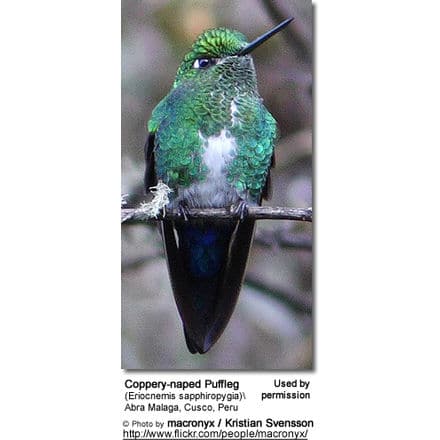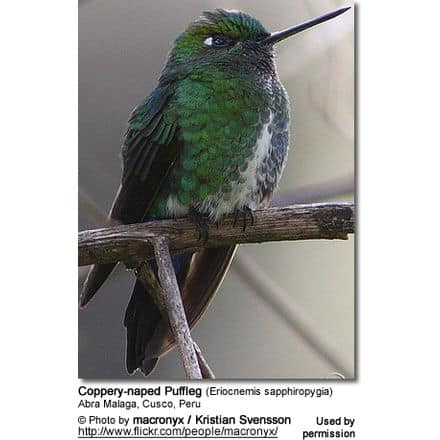Coppery-naped Puffleg
The Coppery-naped Pufflegs (Eriocnemis sapphiropygia) – also sometimes (mistakenly) referred to as Sapphire-vented Puffleg – is a South American hummingbird.
Some authorities include the Coppery-naped Puffleg as a subspecies of the Sapphire-vented Puffleg (Eriocnemis luciani), but morphological (physical) differences support treatment as separate species.
Alternate (Global) Names
Spanish: Calzadito Colilargo Sureño … French: Érione à nuque d’or, Érione à ventre bleu … German: Kupfernacken-Höschenkolibri … Latin: Eriocnemis luciani sapphiropygia, Eriocnemis luciani sapphiropygia/cathatina, Eriocnemis sapphiropygia … Czech: kolib?ík m?d?notýlý … Danish: Kobbernakket Kvastben … Norwegian: Kobbernakkedunfot … Slovak: pancuchárik medenotylý … Swedish: Kopparnackad tofsbena
Distribution / Range
The Coppery-naped Pufflegs occur naturally in the Andes in Peru, where it is found along the wet montane forest edge at an altitude between 2,000 – 4,000 m (~6,500 – 13,000 ft) .

Subspecies and Distribution
-
- Eriocnemis sapphiropygia sapphiropygia (Taczanowski, 1874) – Nominate Race
- Range: East Andes of central and south Peru (Pasco and Junín to Puno).
- [Eriocnemis sapphiropygia marcapatae] – Disputed Race
- Range: Southeastern PeruMostly identical to the nominate race.
- [Eriocnemis sapphiropygia marcapatae] – Disputed Race
- Range: East Andes of central and south Peru (Pasco and Junín to Puno).
- Eriocnemis sapphiropygia catharina Salvin, 1897
- Range: Eastern Andes of northern Peru (Utcubamba Valley).
- Eriocnemis sapphiropygia sapphiropygia (Taczanowski, 1874) – Nominate Race
Description
The Coppery-naped Pufflegs averages 4.25 inches (10.8 cm) in length, including the 2 inch (5 cm) forked, dark blue tail and the 1 1/8 inch (2.9 cm) straight, black bill.
The upper plumage is bronzy green, turning pure green on the rump and upper tail feathers. It has been named for the coppery sheen to its nape (back of the neck). The wings are publish-black. The under plumage is glittering green. The under tail feathers are a glossy sapphire blue.
It has distinctive small white eye spots and snow-white dense feathering around the legs known as “leg puffs” (which are not always visible). These leg puffs are unique to the pufflegs and have been described as resembling “woolly panties” or “little cotton balls” above the legs,
Calls / Vocalizations
Like most hummingbirds, they are mostly silent. Their occasional calls (often given after taking flight) are described as a monotonous repeated metallic “tsip tsip tsip“.

Nesting / Breeding
Hummingbirds are solitary in all aspects of life other than breeding; and the male’s only involvement in the reproductive process is the actual mating with the female. They neither live nor migrate in flocks; and there is no pair bond for this species. Males court females by flying in a u-shaped pattern in front of them. He will separate from the female immediately after copulation. One male may mate with several females. In all likelihood, the female will also mate with several males. The males do not participate in choosing the nest location, building the nest or raising the chicks.
The female Coppery-naped Puffleg is responsible for building the cup-shaped nest out of plant fibers woven together and green moss on the outside for camouflage in a protected location in a shrub, bush or tree. She lines the nest with soft plant fibers, animal hair and feather down, and strengthens the structure with spider webbing and other sticky material, giving it an elastic quality to allow it to stretch to double its size as the chicks grow and need more room. The nest is typically found on a low, thin horizontal branch.
The average clutch consists of two white eggs, which she incubates alone, while the male defends his territory and the flowers he feeds on. The young are born blind, immobile and without any down.
The female alone protects and feeds the chicks with regurgitated food (mostly partially-digested insects since nectar is an insufficient source of protein for the growing chicks). The female pushes the food down the chicks’ throats with her long bill directly into their stomachs.
As is the case with other hummingbird species, the chicks are brooded only the first week or two, and left alone even on cooler nights after about 12 days – probably due to the small nest size. The chicks leave the nest when they are about 20 days old.

Diet / Feeding
The Coppery-naped Pufflegs primarily feed on nectar taken from a variety of brightly colored, scented small flowers of trees, herbs, shrubs and epiphytes.
Hummingbird Resources
- Hummingbird Information
- Hummingbird Amazing Facts
- Attracting Hummingbirds to Your Garden
- Hummingbird Species
- Feeding Hummingbirds



